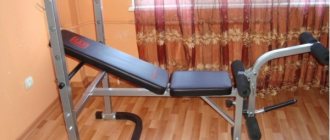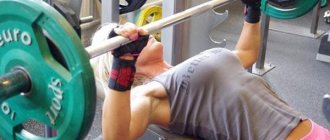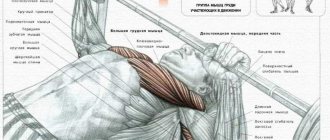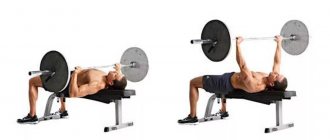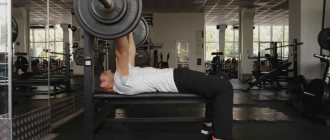The bench press is a universal exercise. It is equally suitable for developing strength and increasing muscle mass in the chest and shoulder groups.
The bench press is a basic exercise. It develops the entire “top” - pectoral, shoulder girdle, triceps and even core muscles.
But - we have said this many times and we will repeat it again - muscles are formed not in the gym, but in the kitchen. If you do not provide yourself with an adequate amount of protein and microelements, forget about textured breasts. If you don’t have time or are too lazy to cook, order food delivered. We recommend Growfood or MF Kitchen, but this is a matter of taste, the main thing is to keep eating.
Regarding sports nutrition, in particular protein, we recommend taking a closer look at the Lactomin market. These are high-quality German raw materials and the lowest prices. Link here.
Bench press exercise - analysis
The bench press requires a detailed analysis. Let's think together - what is the most popular question for a gym visitor? Of course, “How much do you bench?” And every more or less experienced athlete will confidently answer that we are talking about the bench press. At the same time, there is a misconception - if the exercise is massive, then it is simple. In fact, everyone (as in the case of, say, running in the snow) has their own unique technique, and it is very important to perform the bench press in accordance with your goals.
The bench press is an extremely broad topic. We have already touched on the specifics of abdominal exercises and discussed a lot about running. But you can’t fit everything into a short article, so after reading it, look at the selection of books about bodybuilding - there’s a lot of useful stuff there. Link here.
Why is exercise dangerous?
You should know that the bench press can be a very traumatic exercise. This is due to large scales.
Situations are especially dangerous when an athlete tries to conquer new weights without using the help of a partner in removing the barbell from the racks and bringing it to the starting position. For experienced athletes this is not critical. But beginners often put their muscles at serious risk, moving with giant strides towards the coveted hundred.
Another common problem is a frivolous approach to warming up before the bench press. Some athletes immediately increase their working weight. While they are young, these guys are lucky. Their muscles are elastic and still strong. Over the years, this harsh technique can lead to lifelong shoulder injury. Some become “lucky” owners of injuries after the first training sessions.
To avoid becoming a victim of a shoulder strain or a torn pectoral muscle, remember a few simple rules:
- Warm up your muscles and joints well before performing the bench press.
- Before pressing, do 15-20 intense repetitions with an empty bar (20 kg).
- Move gradually towards the working weight. If your working weight is, for example, 100 kg, first hang 50 kg, then 80 kg. With each intermediate weight, do at least 5-6 repetitions. Ideally - 10.
Don't do the maximum bench press more than once a month. Also, don't work yourself to failure more than twice a week. It all depends on the speed of recovery of your muscles. For some, one hard workout in 7 days is enough, for others, they can work to failure twice in the same period. Everything is individual.
Bench press - main muscles worked:
1) The so-called “direct movers” - they perform the most difficult work and are the main characters. These include the anterior deltoid, clavicular portion of the pectoralis major, sternal portion of the pectoralis major, triceps;
2) When you perform a bench press, “auxiliary movers” also interact with them: the clavicular, subscapularis, teres major and latissimus dorsi muscles, as well as the biceps;
2) Stabilizing muscles - responsible for the correct technique of performing the exercise - stabilize the position of all parts of the body involved in the work.
You must clearly monitor which muscles are involved in the work at each stage of the exercise. This will allow you to track where the minimum load falls and then improve your technique and your overall strength indicators.
Interesting Facts
For a long time on the territory of the USSR, weightlifting was considered the only officially recognized sport, in which the bench press was only a secondary auxiliary exercise.
Everything changed in the 1980s, when all-Union competitions began to be held in disciplines that included the bench press.
During these years, Open Championships in classical powerlifting triathlon were held in the Lithuanian SSR. In 1988, the first international powerlifting meetings between the USSR and the USA took place.
In the United States, this sport has a longer history, so it is not surprising that the Americans noted poor performance technique and remnants of weightlifting movements among Soviet athletes.
However, all these absurdities were quickly corrected, and since the 1990s, Russian powerlifting has kept pace with American powerlifting in its successes.
Russian benchers have inscribed their names in the pantheon of strength glory: Kirill Sarychev, Vladimir Kravtsov and many others. CIS countries are not far behind: Ukraine and Belarus.
Today, the bench press is presented as an independent discipline of the same name in the classic bench press for lifting maximum weight, as well as in the “Russian press,” where it is necessary to lift a certain weight several times.
In the classic bench press they compete in equipped and unequipped divisions, with and without doping control. The standards are sorted by weight categories and sports ranks (II youth category - I adult, KMS, MS, MSMK, elite). There are many federations.
Ryan Keneally conquered the 486kg weight class with his verbose equipment. This is an absolute world record in the bench press. In single-layer equipment, the record holder is Fredrik Smulter, he bench pressed 400 kg.
The championship in the raw bench press is held by Kirill Sarychev, who lifted a weight of 335 kg in 2015.
An interesting example is Maryana Naumova, who bench pressed 60 kilograms at the age of 11. This is an absolute world record among girls under 14 years old in the raw bench press. For such an achievement, Maryana was awarded a place in the Russian Book of Records.
Bench Press Bench, Grip Width and Preparation
For beginners, a grip slightly wider than shoulder width is recommended. In this case, the load is distributed evenly between all working muscle groups. In turn, the wider the grip, the greater the amplitude, the less the load on the triceps and anterior deltoids.
But we do not recommend starting to do the bench press with a grip that is too wide; this can lead to discomfort in the pectoral muscles and shoulder joints. For the same reason, pay significant attention to chest stretching.
Brief summary
The bench press is a basic exercise that fully develops all the muscles of the upper body: pectoral, triceps, deltoids. Its benefits for increasing muscle mass are undeniable.
A huge number of variations of this exercise allows it to find a place in the training process of any athlete who chooses one or another variation based on his interests. 5-15 repetitions will be optimal for a bodybuilder.
Correct placement of the technique will avoid injuries and evenly engage all the muscles working in the exercise. It is better to avoid mistakes at the mastering stage than to try to correct them when the incorrect technique has already been fixed and stored in muscle memory.
Bench press technique
If you work classically, “for strength,” then for each repetition use the full amplitude and fix the barbell at the top and bottom points. In this case, the number of repetitions should usually not be more than six. If you want to use more muscles and reduce the amplitude, you can arch your back (mimicking the “bridge” exercise), using the largest grip width.
For muscle hypertrophy, it is better to shorten the amplitude. In this case, the muscles of the chest and shoulder girdle should be constantly tense. This is achieved by incomplete extension of the elbows and the absence of pauses. The antagonist muscles are switched off. To do this, you need to lie flat on the bench, completely eliminating the deflection of your back. We are talking about the so-called static-dynamic style of execution. In this case, you can even put your legs on the edge of the bench, or even keep them bent in the air, but be careful - this is aerobatics.
Basic mistakes
And again, the vast majority of mistakes in the bench press are made by beginners, although sometimes experienced athletes also make mistakes.
Lifting the pelvis off the bench
When you do a classic bench press, the 3 points of support for your body are your shoulder blades, pelvis and heels. A stool stands more stable on three legs than on two. But this is not the only point.
When you lift your pelvis off the bench, lifting it up, your lower back receives a very strong load - this can cause your back to break. The weight of the barbell is redistributed between the shoulder blades and legs.
Thus, by lifting your pelvis off the bench while performing a bench press, you not only risk losing your balance, but also breaking your back. It is easiest to get injured from this position.
Sharp lowering of the barbell to the chest
One of the most terrible mistakes, leading to fractured ribs and stretched intercostal muscles. As you all have noticed, the chest is quite elastic. When you lower yourself onto a light barbell, your chest acts as a shock absorber. From this position, the bar seems to bounce back, returning back to its original position.
You can't make your job easier this way. The muscles of the chest, triceps and shoulders should work, not the elastic resistance of the chest.
Let's consider this shock-absorbing effect from an anatomical point of view. What happens at this moment? And the following happens: the internal pressure in the chest increases sharply, the lungs experience shock, the joints and ligaments also experience shock.
It happens that one such time is enough to get a serious injury and wake up at night from pain every time you turn from side to side.
Therefore, do not allow the barbell to bounce off your chest. You need to perform the classic bench press smoothly!
Improper breathing
In the bench press, improper breathing is very dangerous. When you lower the barbell to your chest and hold it there with muscle strength, the internal pressure in your chest rises sharply. If you exhale, your lungs will be empty at the bottom. There is no air in them, and therefore they cannot support the volume of the chest. And the chest, in turn, cannot fully absorb shock if you accidentally suddenly lower the barbell onto your chest.
This is the first. Next, to lift the weight, you need to exhale. And you will inhale. What will come of it is better not to try. Believe me - nothing good.
Breathe correctly while doing the bench press, gentlemen athletes!
Speed
You understand that quickly pressing a barbell weighing over one hundred kg is very unsafe. You will need to dampen the inertia when the barbell lowers to your chest - this is an additional risk of tearing your shoulder.
The same thing applies to the clean and jerk - an excessive jerk can lead to exactly the same consequences.
Work slowly, pump up your muscles. Movements should be strong but smooth. No jerking. Even in bench press competitions, athletes don't do this.
The bridge and what it is eaten with
If you are into bodybuilding, you don't need a bridge. By the way, who doesn’t know - a bridge during a bench press is a body position when the athlete arches his lower back as much as possible in order to reduce the distance from the barbell to the chest in its original upper position. This is a kind of officially sanctioned cheating.
It's all about lifting more weight. But not about better muscle pumping. Experienced athletes say that in order to effectively work the chest and shoulders, the barbell must be pressed with a slight (physiologically correct) deflection in the lower back.
We conclude that if you are not chasing scales, the bridge is not for you. Work your muscles. Of course, for those involved in powerlifting, the bridge is a standard element of the program. And you only do the bench press with it. This is a special technique.
Be sure to learn how to get into this position correctly, otherwise you won’t be able to bench press heavy weights. Sometimes you can see how beginners make a bridge by lifting the pelvis high up. In the case of a bridge, the buttocks touch the bench, and the main weight falls on the legs and shoulder blades.
Bench press options
Any bench press begins with a warm-up approach:
- Lie down on the bench so that the bar is above your eyes;
- Spread your legs slightly to the sides, rest your feet on the floor;
- The lower back is slightly arched, but not to the bridge position;
- As you exhale, raise the bar. It should be slightly above the bottom of the chest;
- As you inhale, lower the bar to your chest. Touch your chest. As you exhale, raise the barbell to the top point;
- 15-20 repetitions are done, after which you can gradually move on to working weights;
1) Touch press. After the bar touches your chest, immediately, without pausing, push it upward with all your power.
2) Rack press. Take a position in the power rack. The bar is placed on the stops at chest level. This option is usually used to limit the range of motion of the apparatus in cases where the athlete has suffered an injury or in the absence of a belay partner.
3) Press in the Smith machine. The Smith machine is a convenient design known for its uniqueness. Thanks to the vertical guides, skewing of the barbell is completely eliminated. At the same time, the guides are equipped with special hooks, thereby providing additional safety during exercise. You will not need additional insurance. You can attach the barbell yourself at any time and finish the exercise.
5) Incline bench press.
This option is good because it allows you to train different parts of the chest, depending on the angle of the bench. Compared to the horizontal press, the weights will be lighter. It is necessary to carefully monitor the technique - in this position the risk of injuring the shoulder is significantly higher.
Criteria for choosing a weight bench for home
Working out at home, no less than in the gym, must meet the criteria of effectiveness and safety. When choosing a home bench for bench press, you should consider the following nuances.
Reliability
Strong, thick metal, reliable fastenings and durable adjustment and folding mechanisms are the first things you need to pay attention to. The backrest lift design must withstand heavy loads. The bench itself and the racks must be stable, the parts must not “walk”, otherwise each workout may carry the risk of serious injury. An important point is the width of the racks. When positioned narrowly, there is a risk of improper load distribution and the bar tipping over.
Compactness
When choosing a bench for home use, you should pay attention to the transformation and folding mechanisms. They must be simple and reliable, able to withstand repeated use. Not every living space can accommodate even such a small exercise machine, so a folding bench press and sliding racks for a barbell are the best option for a small apartment. However, you need to understand that a non-separable exercise machine is usually more stable and strong, since it has no moving parts.
Versatility
An ordinary horizontal bench has little functionality. To make more exercises available to the athlete, it can be equipped with additional devices:
- Adjustable parts of the bench allow you to perform the exercise with a normal or reverse incline, which contributes to a comprehensive development of the torso muscles;
- A bench with a leg block will give you the opportunity to pump up your hamstrings, calves and buttocks, as well as perform classic abdominal crunches;
- The support cushion is a comfortable device designed for the belay partner. It allows it to rest securely and help the athlete work with heavy weight;
- A power bench equipped with parallel bars will allow you to perform even more exercises and maximize strength and endurance;
- Special handrails are convenient when performing exercises for the lower abdomen. The athlete, holding on to them with his hands, can securely fix the torso and perform reverse twists;
- Barbell racks with safety nets are necessary when working with heavy weights without the support of a partner. Safety stops do not interfere during the press and will protect the athlete from the bar falling onto his chest if he cannot hold it.
Convenience
A separate power bench will allow you to work efficiently with dumbbells, and a separate barbell rack will allow you to perform squats and deadlifts. It is also important to choose the right length of the bench - your head should not hang down when performing exercises. Tall athletes usually set the tilt angle to 45 degrees, with the back of the head resting against the backrest.
Simplicity
The sporting goods market offers many variations of the same exercise equipment. Complexity of design does not always mean wide versatility. Often, most of the “unique” features are very expensive, but in reality they are never useful. Additional options of the simulator should be understandable and necessary for this particular athlete. Before purchasing, think about exactly what functionality you need so as not to overpay for something that will not be used.
Bench Press Mistakes
1) You neglect warming up. Muscles and joints must be well warmed up, otherwise there is a high risk of injury;
2) In a classic non-strength performance, you are trying to lift your pelvis off the bench. The load will not be distributed correctly. You can injure your lower back or tear your back;
3) You throw the barbell too hard on your chest. No matter how elastic our chest is, ribs can be easily damaged and even broken. Read about static dynamics again;
4) You do not follow the breathing technique: you need to lift the barbell while exhaling sharply, lower it while inhaling;
5) Your movements are jerky and unbalanced. In this case, you risk simply tearing your shoulder ligaments;
6) You do not monitor the position of your legs. Your feet should rest on the floor. The position must be stable; you should not stand on your toes;
7) The position of the hands is not symmetrical, and the grip itself is not balanced. If the distance from the center of the bar to the wrists is different, the risks of injury still increase;
 You can't bend your wrists back! This is an extra load on the hands;
You can't bend your wrists back! This is an extra load on the hands;
9) Same goes for the monkey grip! Gain experience and technical base and then move on to similar experiments;
10) The head should be pressed tightly against the bench. This way you will avoid pinching the cervical vertebrae;
11) You choose the wrong weight. Use the program and gradually increase the working weights, because it is regular muscle stress that provokes the release of testosterone and high-quality muscle hypertrophy.
Warm-up before bench press
A prerequisite for performing the bench press is a thorough warm-up of the whole body. Use basic exercises for your neck, shoulders, arms, body, legs, and joints. After this, you can do a special warm-up before starting the approaches.
- Perform 1-2 sets of bar presses without using additional weight.
- Gradually add weight 5-15 kg at a time and continue doing warm-up sets, reducing the number of barbell lifts.
- Do this warm-up until the working weight is reached.
You can also alternate between different grips during the warm-up. Do a few sets with a classic grip, then do a close-grip biceps press, followed by a wide-grip press to warm up the pectoral muscles.
How to Make Progress in the Bench Press
- Alternate the load and intensity of your training. Experienced athletes devote no more than 2 workouts in a row to their chest. Ideally - once every 5 days;
- Learn to lower the projectile correctly. A competent negative phase is an art.
- Train regularly, constantly work on your technique. Skipping workouts will set you back.
- Get ready for training. Concentrate powerfully on the mechanics of how you will perform the exercise.
Advantages of exercising with dumbbells while lying down
By performing a dumbbell bench press, this allows you to perfectly increase the pectoral muscles. Although lifting a barbell is considered a basic exercise for developing the back, it will not help in the formation of a wide and beautiful chest.
Lying exercises with dumbbells are more effective than lifting a barbell for the chest muscles for the following reasons:
- The role of safety - exercises with dumbbells, especially those done with a neutral grip, place less stress on the elbow joints. The likelihood of injury is much less;
- Extended range of motion. The boundaries of barbell advancement are limited by the bar, but for a dumbbell these boundaries do not matter. They can be lowered low, which creates a greater stretch and contraction of the pectoral muscles;
- Ability to act without an assistant. Classes with dumbbells give beginners and pros the opportunity to work out their chests without the fear of being under a fallen barbell; dumbbells can easily be dropped to the floor if the weight is chosen more than necessary. It is considered the best exercise for women to pump up their breasts in the gym;
- Purposeful action. When lifting a barbell, 60% of the load falls on the chest, 20% on the triceps, and 15% on the anterior deltoid. When exercising with dumbbells, about 75% of the load is placed on the chest muscles. This makes these muscles grow faster;
- Number of options. The barbell lift has 1-3 variations, and dumbbell exercises have many more;
- Availability – The barbell lift is popular and the apparatus is often occupied. Dumbbells are always available and you can do them without being distracted by questions about the number of remaining approaches.
French press
The French press with dumbbells allows you to train your triceps. In a sitting position, the exercise is carried out on an inclined bench, the back is set at a right angle.
Actions for implementation are as follows:
- Two dumbbells are turned around so that the circles are in front and behind, and your hands should be placed palms facing each other.
- The dumbbells are raised above the head with the arms slightly bent at the elbows. You need to try to make the angle of the shoulder in relation to the floor 90 degrees.
- The arms should be bent at the elbow joints so that the shoulder does not move to the sides. The dumbbells are placed behind the head until an acute angle is formed at the elbows.
- The weight is raised to its original position.
First, 10 repetitions are performed to warm up with a light weight, then the working weight is taken and 3-4 sets of 8-10 repetitions are done.
It is advisable to make sure that your elbows do not move to the sides.



